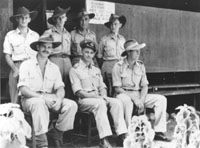


RAAF Meteorological Service
Foreword
Introduction
Chapter 1: The Weather Factor in Warfare
Chapter 2: Establishing and Developing the RAAF Directorate of Met. Services (D.Met.S)
Chapter 3: Recruiting and Training of Personnel
Chapter 4: Meteorology in Aviation
Chapter 5: The Met. Retreating
Chapter 6: The Met. Advancing
Chapter 7: The Met With the Army and the Navy
Chapter 8: Divisional Offices of the Bureau of Meteorology During the War
Chapter 9: Research and Instrumental Development
Chapter 10: The End, Aftermath, and Beyond
Appendix 1
Appendix 2
Appendix 3
Appendix 4
References
Index
Search
Help
Contact us

Following the end of the war came the occupation of Japan by the Allies. The role of D.Met.S. in the occupation was the same as usual—namely, the supply of weather information, advices, and forecasts as required. The occupation period extended from 1945 to 1950, and was, therefore, very much post-World War II.

Former Air Vice-Marshall Brian Eaton wrote: 'One aspect worth mentioning is the RAAF Met. Service at Bofu and Iwakuni during the occupation period. It was truly outstanding . . .'[101] Some Met. officers involved in the occupation were Squadron-Leaders Bob McConnell, Mat Lurie, Arthur Douglas and George Orriell. Squadron-Leaders Allan Cornish and Bill Gibbs were members of an Australian military mission to Japan in late 1945, visiting Tokyo, Kure, Hiroshima and other centres.
In February 1946,1 was still at Milne Bay. Like many others in this mosquito-infested hole on the extreme south-eastern tip of New Guinea, I had for some time been suffering intermittently from malaria. My posting back to Australia came through later that month, and I was allocated a space (there were rarely any passenger seats in service aircraft) on a Douglas Dakota. The evening before my departure, we were entertaining in the mess the officers of a supply ship of the Royal Navy, which had been extensively damaged by hitting a mine in the Solomon Sea. The starboard bow of the vessel had been holed below the waterline. Temporary repairs had been made, and the ship was to sail for Brisbane, hugging the coast as closely as possible at low speed. When the captain learned that I was returning to Australia, he invited me to join his ship as a guest for the voyage. 'He'll be able to fix the weather for us, and we'll certainly need a quiet passage', smiled the captain. The medical officer of my unit thought that the scheduled nine-day journey would be beneficial to me, and supported the suggestion. So, next morning, I had my gear taken down to the wharf, and was soon comfortably berthed on the ship. Actually, we were right in the middle of the tropical cyclone season, but I did not point this out to the sailors. I'd had a quick look at the weather chart, and had decided that the weather along the eastern coast of Australia appeared docile—at least, as far as Rockhampton. There the sheltered water of the Great Barrier Reef gave way to the open sea. There appeared to be a moderate sea with a moderate south-easterly swell rolling up from the Tasman. As we weighed anchor, the weather was really magnificent, and my last impression of Milne Bay was of its tropical splendour—never to be trusted, as cloud and rain sweep across the scene in minutes.
Organisations in Australian Science at Work - Directorate of Meteorological Services (D.Met.S)
People in Bright Sparcs - Cornish, Allan William; Gibbs, William James (Bill)
 |
Bureau of Meteorology |  |
© Online Edition Australian Science and Technology Heritage Centre and Bureau of Meteorology 2001
Published by Australian Science and Technology Heritage Centre, using the Web Academic Resource Publisher
http://www.austehc.unimelb.edu.au/fam/0328.html